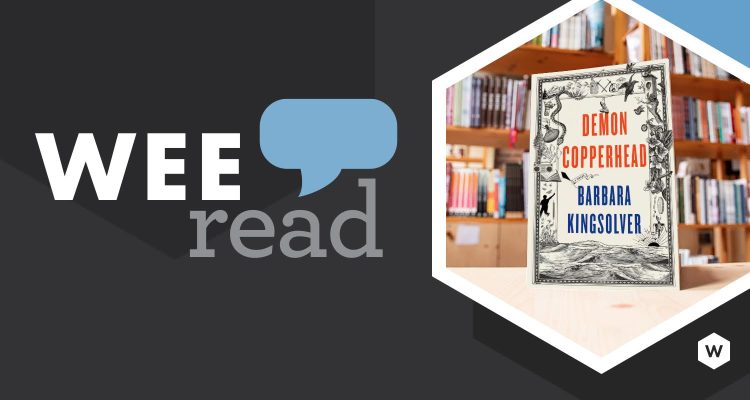“First, I got myself born.” So begins the saga of Damon Fields, AKA Demon Copperhead, the titular protagonist of Barbara Kingsolver’s 2022 award-winning novel. Coming of age in southern Appalachia during the late ‘90s and early aughts, Demon’s life is hardscrabble from the beginning. His life of struggle begins at birth, born in a trailer en caul (inside the amniotic sac) to an already-passed-out teenage mother, leaving Demon to do the heavy lifting of the birthing process. His father, recently deceased, provides Demon with no more than his name and Melungeon looks.
Though his childhood is less than ideal due to poverty and his mother’s lapses in sobriety, Demon manages thanks to the generous Peggots, an elderly neighbor couple, and their grandson Matt, nicknamed Maggot, with whom Demon roams the woods of Lee County, Virginia. Demon was born with a fighting spirit, and this inner strength keeps him going through his mother’s repeated lapses and, later, with a tyrannical stepfather. Following a nearly fatal overdose, however, Demon’s mother is deemed unfit to care for him, and he is placed in foster care. After years spent being passed from one uncaring foster home to another, he decides to strike out on his own and find his father’s kin in Kentucky. Here, he finds his paternal grandmother, the formidable Betsy Woodall, and learns about the father and side of the family he never got to meet. With the help of his uncle, Demon explores his Melungeon heritage and begins to understand his connection to his area and his people.
After returning to Lee County, Demon is placed in a new foster home, thanks to his grandmother’s connections, with the much-lauded high school football Coach Winfield. The stability of the household allows Demon to return to school and, thanks to the intervention of a caring teacher, into the Gifted and Talented program for his artistic ability. Without the constraints of his previous foster home placements, he is able to pursue his two passions: football and art. His football career is short-lived, however, as Demon sustains a debilitating injury on the field. To alleviate the pain and return to the field, he is prescribed a new, reportedly non-addictive drug: Oxycontin. Demon’s mettle is further tested as he and his community battle the ensuing influx of drugs and the throes of addiction that follow.
Inspired by—and in many ways the spiritual successor to Charles Dickens’s David Copperfield—Kingsolver’s Demon Copperhead is an indictment against the failings of modern American society. A native of Kentucky, Kingsolver delves into the issues facing Appalachia with empathy and understanding. While many are quick to blame Appalachians for, well, just about everything plaguing the country, Demon Copperhead spurs people to check their bias by giving insight into the region’s problems. And unlike other works that discuss the effects of opiates on Appalachia, Kingsolver makes it clear that the blame sits squarely on the pharmaceutical companies that pushed an addictive drug onto an unknowing public. Demon and others in the story are not made out to be villains or even bad people for falling victim to addiction; they are, instead, complex people who have their own hardships and are merely trying to ease the pain.
Kingsolver does not candy-coat any of the issues facing Demon and his community, and this frankness can be hard to swallow; nevertheless, Demon Copperhead is important and necessary, a rallying call to do better. Demon represents the children mired in the foster care system and largely overlooked by school administrators; Appalachians struggling with poverty and lack of opportunity, forced to leave the home they love for better jobs; and the victims of pharmaceutical greed, fighting addiction to pills prescribed by uncaring or unknowing doctors. By creating Demon—a wry, resilient, and compassionate young man—Kingsolver provides a representative for these issues that readers can relate to and cheer on. Readers will sympathize with Demon and want him to succeed, to overcome, to do better—and will recognize that he is able to do so not only thanks his own resilience but because of the people that provide him support: his friends, family, and teachers who acknowledge his struggle and potential.
As you can likely gather, Demon Copperhead is not exactly an easy, breezy beach read. If you are tenderhearted like me, it will probably break your heart at least a few times. Demon has a long road through poverty and neglect and addiction, but there are pockets of joy and comfort throughout thanks to friendship, community members who care and intervene, and Demon’s own connection to nature. The novel presents the region as it is—the good, the bad, and the ugly—and will hopefully leave readers with an understanding and appreciation for Appalachia and its people. I cannot fit all the things I loved about this book into one review, how it was heartbreaking and life-changing and powerful, so it all comes down to one recommendation: read it!
Demon Copperhead can be found in many of the places you buy books, including Amazon, Barnes & Noble, and Walmart.



